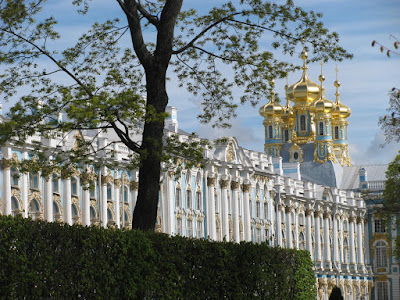Today is free at leisure to explore St. Petersburg on your own.
Pushkin and Pavlovsk Palaces and Parks (AM)
Travel to Pushkin to visit Catherine's Palace, the summer residence of the Russian imperial family, which has a long history that begins in the early 18th century. In 1708 Peter I presented these lands to his second wife Catherine I. The first palace to be built on the land was a two story stone palace but was demolished and reconstructed several times. Explore the palace and the surrounding park and learn of the long history behind this beautiful site. Take some time to view the amber panels backed with gold leafs and mirrors in the famous Amber Room which was reconstructed after the second world war. Continue to Pavlovsk, the family residence of Paul I. View 19th century paintings that belonged to Paul I, and items that were made by Empress Maria Fevorovna. Pavlovsk is located on one of the country's largest and most picturesque estates (1500 acres), and is uniquely landscaped to incorporate the surrounding swamps and forest.
Overnight: Cruise
Meals: Breakfast, Lunch, Dinner
These palaces are breathtaking to say the least. It was a beautiful day to visit such incredible buildings and grounds.
First stop was Pushkin. The Czar's (actually the Czariza's) palace outside of Saint Petersburg is a magnificent building. It is situated on a hilltop near a small town called Pushkin after the famous Russian poet. The town was originally the King's Village where all the servants lived, but it was later renamed to honour the poet.
This palace was mouthdroppingly beautiful. There were many gasps as we approached the palace.
We were greeted by a band (who also had copies of their CDs for sale)
Mouths were agape as we stepped inside, well, after we put on our slippers to "protect" the floors. I think this is a ploy by the babushkas to have us clean and polish the floors.
The legendary Amber Room is on Pushkin Palace, however, no photos are allowed.
To create this extraordinary chamber, Rastrelli used the panels of amber mosaic originally destined for an Amber Cabinet at Konigsberg Castle and presented to Peter the Great by Friedrich-Wilhelm I of Prussia, and surrounded them with gilded carving, mirrors, more amber panels created by Florentine and Russian craftsman (comprising a total of 450kg of amber), and further mosaics of Ural and Caucasus gemstones. The room was completed in 1770. Due to the fragility of the materials used, a caretaker was employed constantly to maintain and repair the decorations, and major restoration was undertaken three times in the 19th century. The room was used to house a substantial collection of amber-work and Chinese porcelain. In 1941, when German troops took Tsarskoe Selo, the Amber Room was dismantled in 36 hours, and shipped to Konigsberg in a tawdry pretence at historical fidelity. As the Nazi war machine crumbled, the panels were crated up and moved out of danger, but their eventual fate is unknown.
In 1982, the order was given to begin the recreation of the Amber Room, a process that took over 20 years and cost more than $12 million. Opened in 2003 by President Vladimir Putin and Chancellor Gerhard Schroeder, the restored Amber Room is a truly unique monument, and a testament to the painstaking care of the craftsmen who worked on it.
Time to step outside and explore the grounds.
Time for a box lunch before we move on - not happy campers with the menu!!
After that uninspiring lunch we move on to another palace where I'm sure the guests were fed better!
Pavlovsk Palace
This website gives a very detailed and interesting tour of the palace if you are interested in further details.
The task of designing the palace was originally assigned by Catherine the Great to Charles Cameron, the Scottish-born architect who had won the Empress's lasting favour with the work he did at Tsarskoe Selo. Construction began in 1782, but Cameron's modest design and his penchant for the absolute simplicity of Palladianism and the historical purity of Adamesque were not to the liking of Pavel and his wife Maria Feodorovna, and they charged Cameron's assistant, Vincenzo Brenna, with the task of extending the palace and creating a more imposing and regal building. Brenna quickly became Pavel's favourite architect, and went on to design alterations on the palace at Gatchina, and the Mikhailovsky Castle in St. Petersburg. His great achievement, both there and at Pavlovsk, was to combine the future Tsar's eclectic tastes into an organic and harmonious architectural solution.
Although lacking the dazzling splendour of the estates at Tsarskoe Selo (Pushkin) and Peterhof, Pavlovsk is well worth visiting both for the treasures in the elegant palace and for the charming, rambling park, which is one of the largest and finest English-style landscape gardens outside the UK.
Both the Park and the Palace at Pavlovsk were victims of wanton destruction during the Nazi occupation, and the extraordinary restoration project was not completed until the mid-1950s. Fortunately, there were extensive blueprints available for all aspects of the estate, so what you see now is almost entirely faithful to the original designs.
































































No comments:
Post a Comment
This blog does not allow anonymous comments.